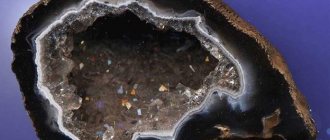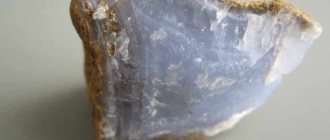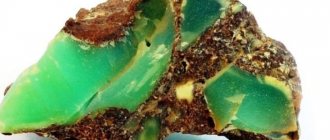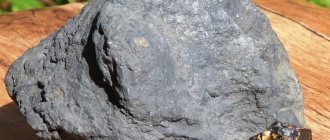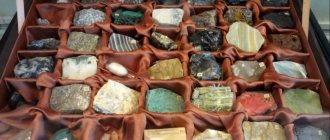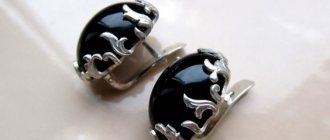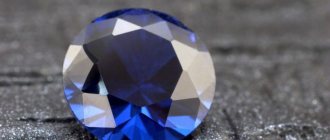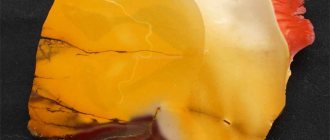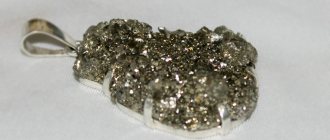Other meanings of this word:
- "Aphrodite's Nail"
- "turn" socks into stone
- agate a la zebra
- agate in “prison” clothes
- striped agate
- Striped agate
- Agate with zebra print
- Agate mineral
- American classic rap group
- It is said that this stone not only clears the mind and strengthens memory, but also promotes the healing of wounds and fractures
- which stone was considered “sad” by the Arabs since ancient times?
- Which stone has the Arabs considered “sad” since ancient times?
- which stone protects those born under the sign of Capricorn
- What stone protects those born under the sign of Capricorn?
- Striped stone
- Stone for jewelry.
- Agate stone
- stone - gift from Joseph
- stone that causes prophetic dreams
- Stone, patron of Capricorns
- brown ornamental mineral
- Brown Gem
- Banded agate
- m. onychium, a type of agate with an eye, spectacled agate: this eye comes from multi-colored layers, which the ancient Greeks used for thick carvings on stones. Onyx ring,
- Mineral, ornamental stone, “stone of leaders”
- Mineral, a type of agate
- Mineral, chalcedony
- One of the "Bible Stones"
- Ornamental stone, 'stone of leaders'
- Ornamental stone, which can be carnelian and agate, carnelian and chalcedony
- An ornamental stone set in silver cures heart disease and insomnia, drives away black thoughts
- ornamental chalcedony quartz
- Suitable stone for cameos
- striped agate
- striped stone
- striped quartz
- Semi-precious stone, a variety of agate
- Turn your socks into stone
- A variety of radiant lime spar (calcite, less commonly aragonite)
- Agate genus
- Chalcedony genus
- the longest river in Antarctica
- Gem of the Leaders
- Sardonyx as a mineral
- Aztec sacred stone
- carnelian...
- Chalcedony
- Chalcedony, sardonyx
- chalcedony quartz
- chalcedony quartz, gem
- black and white agate
- Black and white agate
- what comes out of the word “socks” if the letters in it are swapped
- What will come out of the word “socks” if the letters in it are reversed?
- Jewelry stone used for flooring in ancient Rome
Burmese legend of the origin of the name ruby
In Burma there is a very beautiful legend about a proud, strong eagle, whose name was Lal. He lived away from everyone, preferring to enjoy solitude in a silicon cave located high in the mountains beyond the Irwadi River.
Birds, animals, large predators knew about the strength and beauty of this eagle. They avoided meeting him and even eagle owls always hid in a hollow if this bird appeared on the horizon at night. Lal inspired awe and fear, he was feared and admired.
Over time, the eagle's powers weakened. White feathers began to appear on his chest, indicating that old age was very close. Now the eagle was unable to circle in the sky for a long time, he began to shorten his flights and could only freely fly around nearby fields and forests 10 times. One day Lal wanted to soar into the blue sky, spreading his wings wide, but he did not have the strength to simply lift himself off the ground. This moment meant only one thing - his old age had come and his life would soon end. He had to give up his favorite hunt. There was no strength to chase the roe deer; they only had to destroy nests in the forest, eating small prey.
After another short excursion, Lal returned to the cave. An owl was sitting nearby, but now he did not run away in fear from the eagle, but calmly looked at him. The eagle owl came to offer to share the prey with Lal on the condition that the eagle would not touch his babies. The eagle began to remember that before his prey had been fast roe deer and other animals, but now he was offered only shrews. The mere thought of this darkened him, making him shudder with shame and contempt.
The eagle drove the eagle owl away, and at night he thought about the words of the raven he had met once. Then they asked him what was better - to be an ant that crawls on the ground or a tiger that died. It was at this moment that the eagle realized that everything must have its time. You need to be born and die on time, without trying to deceive fate.
Lal gathered his last strength and soared as high as he could. Birds and animals saw him in the setting rays of the sun. This flight became a farewell flight. At a height, Lal folded his wings and fell like a stone onto a sharp rock. The Irrawaddy River was stained with his blood, turning into shining red stones. These were the most beautiful Burmese rubies in the world.
Agree, such a poetic description of the origin of the stones makes them even more attractive and mysterious.
Cost of artificial stones
Many people neglect cultured stones, considering them to be glass. In fact, such diamonds are not cheap; the price of some is higher than their natural counterparts. There are several reasons:
- Synthesized stones, especially white transparent ones, are visually indistinguishable from real minerals.
- Natural crystals are not as flawless as artificial ones. They have inclusions, unlike their cultured counterparts with absolute purity.
- Synthetic diamond is stronger, does not fade, and does not require special care.
The price of a stone is determined by its weight, quality of cut, and method of creation.
Cubic zirconia is the most accessible. A cut specimen costs $1.5–6 per carat. Moissanite is much more expensive – $75–155 per carat.
The cost is influenced by the color - for a yellow diamond they will ask for $200-275 per carat, for a pinkish-orange one - from $3000.
Artificial Diamond Colors
Natural diamonds have different colors or shades. The basic range of man-made pebbles is poorer - yellow, blue, colorless. Each is attractive in its own way:
- White. The most desirable, since traditionally a diamond is associated with a white transparent background. But their production is the most labor-intensive. The crystal grows slowly; you must constantly ensure that no nitrogen gets in (otherwise the color will turn yellowish) or boron (bluish). Even one-carat sparkly little ones are popular.
- Blue. The range varies from sky blue to deep blue. The color is created by boron impurities, the weight reaches 1.25 carats.
- Yellow. The easiest look to create. The range of colors - from rich lemon to exquisite yellowishness - is created by nitrogen impurities. Sometimes the result is an optimistic fiery orange. Diamonds weigh up to two carats.
Other colors are obtained after additional processing of the base crystal. So, in order to synthesize the iconic black diamond for many, nickel is used as a catalyst.
The color is indicated by a number. For colorless it is 1. Such stones are called pure diamonds.
Diamond production technologies
Nowadays, several technologies are used to produce synthetic stone, each of which has its own characteristics. The most reliable, but most expensive technology is to produce diamond from crystalline carbon, which is placed in a special press for processing. First, water is supplied to the material being processed using powerful pumps. This creates high pressure. The water then freezes under the influence of the refrigerant, causing the pressure to increase up to 10 times. At the last stage, the chamber containing the carbon is connected to the electrical busbars and a powerful current is supplied for a few fractions of a second. Under the simultaneous influence of temperature and pressure, graphite is transformed into hard stone. After this phase, the press is defrosted, the liquid is drained and the finished artificial diamond is taken out.
WHERE SYNTHETIC DIAMONDS ARE USED
High tech
The main areas of application of artificial diamonds are industry and high technology:
- cutting tool - artificial diamonds are one of the hardest substances;
- thermal conductors - the combination of high thermal conductivity and minimal electrical conductivity makes artificial stone indispensable as a heat sink for high-power lasers and transistors;
- optics - natural diamonds are not suitable for these purposes, as they have too many defects;
Moissanite
Jewelry industry
The technological breakthrough has raised the question of the need for jewelry and diamond mining companies to control the flow of artificial stones into the jewelry market. Now the growth of their sales is limited legally. In addition to this, some companies are opening their own production of artificial jewelry diamonds.
That's exactly what De Beers did. The diamond mining corporation refused to engage in diamond production for a long time. However, in 2022, she created a subsidiary, Lightbox Jewelry, which began selling artificial stones under its own brand.
Story
The Frenchman Henri Moissan was the first to tell the world what an artificial diamond is at the beginning of the 20th century. He discovered the most similar stone, finding meteor fragments in the crater. And he became a Nobel laureate.
Another popular analogue, synthesized by Soviet scientists in 1976, is called cubic zirconia.
Diamonds are grown on the basis of high-carbon substances - graphite, purified soot, coal. There are two main methods, so a distinction is made between HPHT and CVD crystals.
The primordial mineral and the created double are equally inconspicuous in appearance; both sparkle only after cutting.
How is stone grown?
An artificial diamond is grown in a special chamber. The diamond seed is placed under a press and a special temperature regime is observed. After seven days, using this method, you can see a real diamond. If the quality does not suit the manufacturer, then the stone is processed again using the same technology. Thanks to the press and high temperature, you can get a fairly high quality analogue.
The second method is based on the use of a gaseous medium. The diamond seed is placed in a low pressure chamber. Evaporated carbon and oxygen are applied to the diamond particle in layers. Growing using these methods allows you to obtain high-quality analogues that are not much different from a real diamond. It takes only two days to create such stones. Once upon a time, diamonds were replaced with cubic zirconias and moissanites. Crystal and zircon were used for rings. So they looked elegant and sophisticated on the products.
How crystals are grown
Today, stones are made in two main ways - physical and chemical. It is possible to create diamonds at home.
Copying nature
The diamond seed is placed under a press in a chamber with high temperature and pressure. After a week, a high-quality analogue is obtained. If necessary, repeat the procedure.
Diamonds are obtained in the form of cubes or octahedrons, which distinguishes them from natural ones. The technology is known as HTHP or "GEPOL".
In a gas environment
The diamond seed is placed in a chamber containing methane or other carbon-containing gas at low pressure. The energy of the microwave beam destroys the gas molecules, and the evaporated carbon and hydrogen are applied to the grain layer by layer, creating diamond plates.
The process takes two days; several plate-like crystal layers can be grown at a time. They have rough graphite edges that are black or brown. The crystals are brought to shine by heat treatment and cut.
The characteristics of specimens grown in a chamber or capsule are identical to natural ones.
Making a diamond at home
The process takes place in a microwave oven - perfectly washed and dried. You will also need:
- three graphite rods 3 mm thick and a couple of centimeters long - from a simple pencil;
- two cups;
- olive oil;
- linen or cotton thread 14–16 cm long.
Operating procedure:
- Pour some oil into a plate. Lay a thread along the diameter that will absorb the oil.
- Tie the oiled thread with a loose knot and pass the graphite through it. The rod is placed on supports made of matches without heads or toothpicks.
- The knot is tightened around the rod until it stops for half an hour to soak it in oil.
- The thread is removed carefully so that the lead is not damaged and the oil remains on the intended area of the rod.
- The mug is turned upside down and two clean rods are placed parallel to it. Oiled graphite is placed on them. The structure is covered with a second cup.
- Everything is placed in the microwave at maximum temperature and time.
The man-made diamond will end up in the area where the oil was concentrated. It may cause sparks in the oven that will disappear after a few minutes. Remove after cooling.
Growing diamond with methane
They also use a simpler technology for the production of synthetic stone - the explosion method, which allows you to grow an artificial crystal under the influence of methane. Very often, the production of artificial diamonds occurs using two technologies. The fact is that in the first case it is possible to obtain the highest percentage yield of diamonds, but they will be very small. The second technology allows you to significantly increase the resulting synthetic stone by blowing methane under the influence of a temperature of about 1100 ºС. The explosion method makes it possible to obtain an artificial diamond of any size.
Sources
- https://www.krossvordskanvord.com/imitaciya-brillianta-6-bukv
- https://TheMineral.ru/imitatsii/iskusstvennye-almazy
- https://vkamen.ru/interesno/iskusstvennyj-brilliant
- https://SilverRill.ru/kamni/kak-nazyvaetsya-iskusstvennyj-brilliant.html
What is an artificial diamond
Synthetic diamonds, or man-made diamonds, are human-grown crystals. They are created from the same carbon as natural ones, have a structure, composition, and physical properties similar to natural stones. All diamonds are distinguished by dispersion; other characteristics depend on the method of creation.
Cultured diamonds are usually stones up to 1 carat. Synthesizing larger specimens does not pay off, although this may change. For example, a 10-carat deep blue diamond was grown in Russia. It was obtained under conditions that simulate natural ones. The stone has an emerald cut, impeccable shape and shine, and inclusions are visible only under tenfold magnification.

